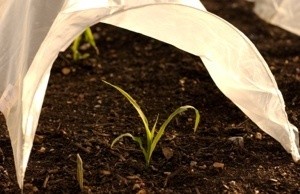
Row covers are wonderful and often underutilized organic gardening tools. Made out of lightweight, synthetic fabrics, they can be placed over entire rows of plants or individual pots for a variety of purposes, all of which usually result in greater yields.
Row covers usually come in two basic weights: lightweight for use as an insect or animal barrier, and heavyweight that provides plants with protection from frost. Many gardeners prefer the lightweight covers, because they can be doubled up (layered) early and late in the season to provide extra protection against the cold.
Most row covers will last at least 2 growing seasons. They are typically available in a variety of widths and lengths; from individual sheets to large rolls that can be cut to fit as needed. You can extend their life by keeping them folded and stored away from moisture when not in use. When it's time to replace them, old covers make good weed barriers when laid down under mulch, and will offer erosion protection when laid over the top of newly seeded or disturbed soil.
Row covers are easy to install. Simply lay the covers over the garden bed. A lightweight row cover can be draped directly over the plants. As the plants grow, the cover is pushed up and simply 'floats' over the top of them. Double layers of lightweight covers and heavier fabrics need to be supported by metal or plastic hoops. The edges can be secured with soil, rocks, bricks, or U-shaped 'pins' to prevent insects and animals from getting inside.
In most cases, row covers need to be pulled back or removed for plants that require pollination by beneficial insects or the wind. Don't make the mistake of removing the covers only during the day. Pollination sometimes occurs at night, so remove them as soon as flowers appear. For self-pollinating crops and edibles like salad greens, covers can be left on from planting until harvest.
Most plants prefer to grow at temperatures between 70-80 degrees F. Unless you like your vegetables cooked before they are harvested, row covers should also be removed when late season temperatures surpass 80 degrees F. If temperatures are expected to dip again at night, be sure to put it back on an hour or so before sunset, to trap a bit of the day's warmth.
Row covers create a moist, warm environment for plants, weeds, too. Weeds thrive in the protected conditions under row covers, so be prepared to remove the covers regularly to weed.

About The Author: Ellen Brown is an environmental writer and photographer and the owner of Sustainable Media, an environmental media company that specializes in helping businesses and organizations promote eco-friendly products and services. Contact her on the web at http://www.sustainable-media.com
Add your voice! Click below to comment. ThriftyFun is powered by your wisdom!